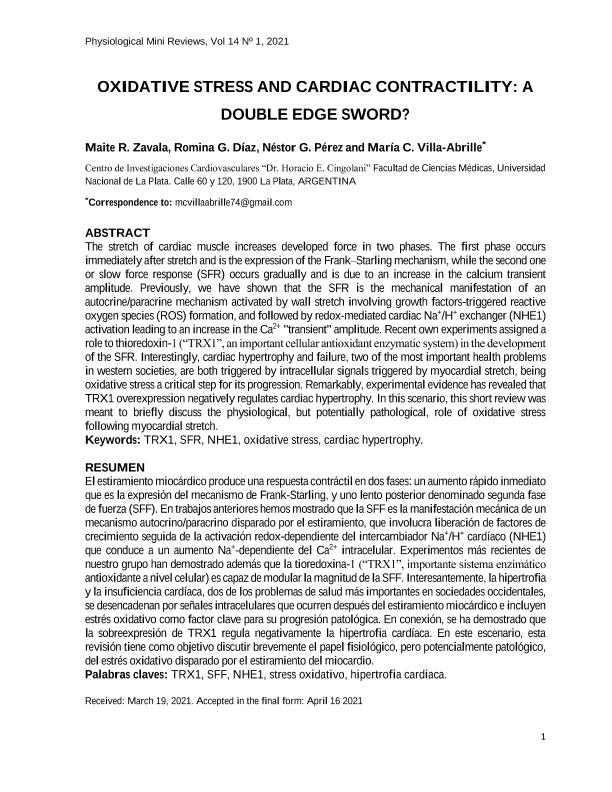Mostrar el registro sencillo del ítem
dc.contributor.author
Zavala, Maite Raquel

dc.contributor.author
Diaz, Romina Gisel

dc.contributor.author
Perez, Nestor Gustavo

dc.contributor.author
Villa-Abrille, María Celeste

dc.date.available
2023-01-03T18:30:03Z
dc.date.issued
2021-01
dc.identifier.citation
Zavala, Maite Raquel; Diaz, Romina Gisel; Perez, Nestor Gustavo; Villa-Abrille, María Celeste; Oxidative stress and cardiac contractility: a double edge sword?; Sociedad Argentina de Fisiología; Physiological mini-reviews; 14; 1; 1-2021; 1-13
dc.identifier.uri
http://hdl.handle.net/11336/183226
dc.description.abstract
The stretch of cardiac muscle increases developed force in two phases. The first phase occurs immediately after stretch and is the expression of the Frank–Starling mechanism, while the second one or slow force response (SFR) occurs gradually and is due to an increase in the calcium transient amplitude. Previously, we have shown that the SFR is the mechanical manifestation of an autocrine/paracrine mechanism activated by wall stretch involving growth factors-triggered reactive oxygen species (ROS) formation, and followed by redox-mediated cardiac Na+ /H+ exchanger (NHE1) activation leading to an increase in the Ca2+ "transient" amplitude. Recent own experiments assigned a role to thioredoxin-1 (“TRX1”, an important cellular antioxidant enzymatic system) in the development of the SFR. Interestingly, cardiac hypertrophy and failure, two of the most important health problems in western societies, are both triggered by intracellular signals triggered by myocardial stretch, being oxidative stress a critical step for its progression. Remarkably, experimental evidence has revealed that TRX1 overexpression negatively regulates cardiac hypertrophy. In this scenario, this short review was meant to briefly discuss the physiological, but potentially pathological, role of oxidative stress following myocardial stretch.
dc.description.abstract
El estiramiento miocárdico produce una respuesta contráctil en dos fases: un aumento rápido inmediato que es la expresión del mecanismo de Frank-Starling, y uno lento posterior denominado segunda fase de fuerza (SFF). En trabajos anteriores hemos mostrado que la SFF es la manifestación mecánica de un mecanismo autocrino/paracrino disparado por el estiramiento, que involucra liberación de factores de crecimiento seguida de la activación redox-dependiente del intercambiador Na+ /H+ cardíaco (NHE1) que conduce a un aumento Na+ -dependiente del Ca2+ intracelular. Experimentos más recientes de nuestro grupo han demostrado además que la tioredoxina-1 (“TRX1”, importante sistema enzimático antioxidante a nivel celular) es capaz de modular la magnitud de la SFF. Interesantemente, la hipertrofia y la insuficiencia cardíaca, dos de los problemas de salud más importantes en sociedades occidentales, se desencadenan por señales intracelulares que ocurren después del estiramiento miocárdico e incluyen estrés oxidativo como factor clave para su progresión patológica. En conexión, se ha demostrado que la sobreexpresión de TRX1 regula negativamente la hipertrofia cardíaca. En este escenario, esta revisión tiene como objetivo discutir brevemente el papel fisiológico, pero potencialmente patológico, del estrés oxidativo disparado por el estiramiento del miocardio.
dc.format
application/pdf
dc.language.iso
eng
dc.publisher
Sociedad Argentina de Fisiología
dc.rights
info:eu-repo/semantics/openAccess
dc.rights.uri
https://creativecommons.org/licenses/by-nc-sa/2.5/ar/
dc.subject
TRX1
dc.subject
SFR
dc.subject
NHE1
dc.subject
OXIDATIVE STRESS
dc.subject
CARDIAC HYPERTROPHY
dc.subject.classification
Otras Ciencias Biológicas

dc.subject.classification
Ciencias Biológicas

dc.subject.classification
CIENCIAS NATURALES Y EXACTAS

dc.title
Oxidative stress and cardiac contractility: a double edge sword?
dc.type
info:eu-repo/semantics/article
dc.type
info:ar-repo/semantics/artículo
dc.type
info:eu-repo/semantics/publishedVersion
dc.date.updated
2022-09-06T19:49:09Z
dc.identifier.eissn
1669-5410
dc.journal.volume
14
dc.journal.number
1
dc.journal.pagination
1-13
dc.journal.pais
Argentina

dc.journal.ciudad
Ciudad Autónoma de Buenos Aires
dc.description.fil
Fil: Zavala, Maite Raquel. Consejo Nacional de Investigaciones Científicas y Técnicas. Centro Científico Tecnológico Conicet - La Plata. Centro de Investigaciones Cardiovasculares "Dr. Horacio Eugenio Cingolani". Universidad Nacional de La Plata. Facultad de Ciencias Médicas. Centro de Investigaciones Cardiovasculares "Dr. Horacio Eugenio Cingolani"; Argentina
dc.description.fil
Fil: Diaz, Romina Gisel. Consejo Nacional de Investigaciones Científicas y Técnicas. Centro Científico Tecnológico Conicet - La Plata. Centro de Investigaciones Cardiovasculares "Dr. Horacio Eugenio Cingolani". Universidad Nacional de La Plata. Facultad de Ciencias Médicas. Centro de Investigaciones Cardiovasculares "Dr. Horacio Eugenio Cingolani"; Argentina
dc.description.fil
Fil: Perez, Nestor Gustavo. Consejo Nacional de Investigaciones Científicas y Técnicas. Centro Científico Tecnológico Conicet - La Plata. Centro de Investigaciones Cardiovasculares "Dr. Horacio Eugenio Cingolani". Universidad Nacional de La Plata. Facultad de Ciencias Médicas. Centro de Investigaciones Cardiovasculares "Dr. Horacio Eugenio Cingolani"; Argentina
dc.description.fil
Fil: Villa-Abrille, María Celeste. Consejo Nacional de Investigaciones Científicas y Técnicas. Centro Científico Tecnológico Conicet - La Plata. Centro de Investigaciones Cardiovasculares "Dr. Horacio Eugenio Cingolani". Universidad Nacional de La Plata. Facultad de Ciencias Médicas. Centro de Investigaciones Cardiovasculares "Dr. Horacio Eugenio Cingolani"; Argentina
dc.journal.title
Physiological mini-reviews
dc.relation.alternativeid
info:eu-repo/semantics/altIdentifier/url/https://pmr.safisiol.org.ar/issue/oxidative-stress-and-cardiac-contractility-a-double-edge-sword/
Archivos asociados
